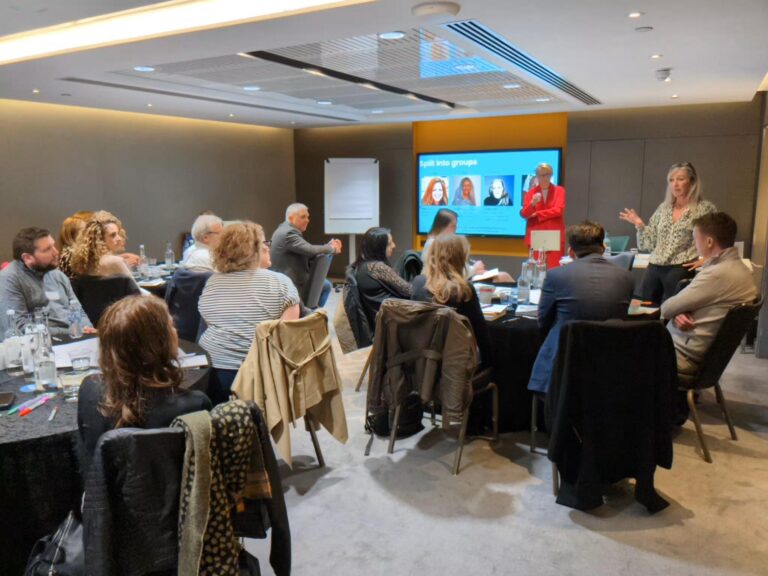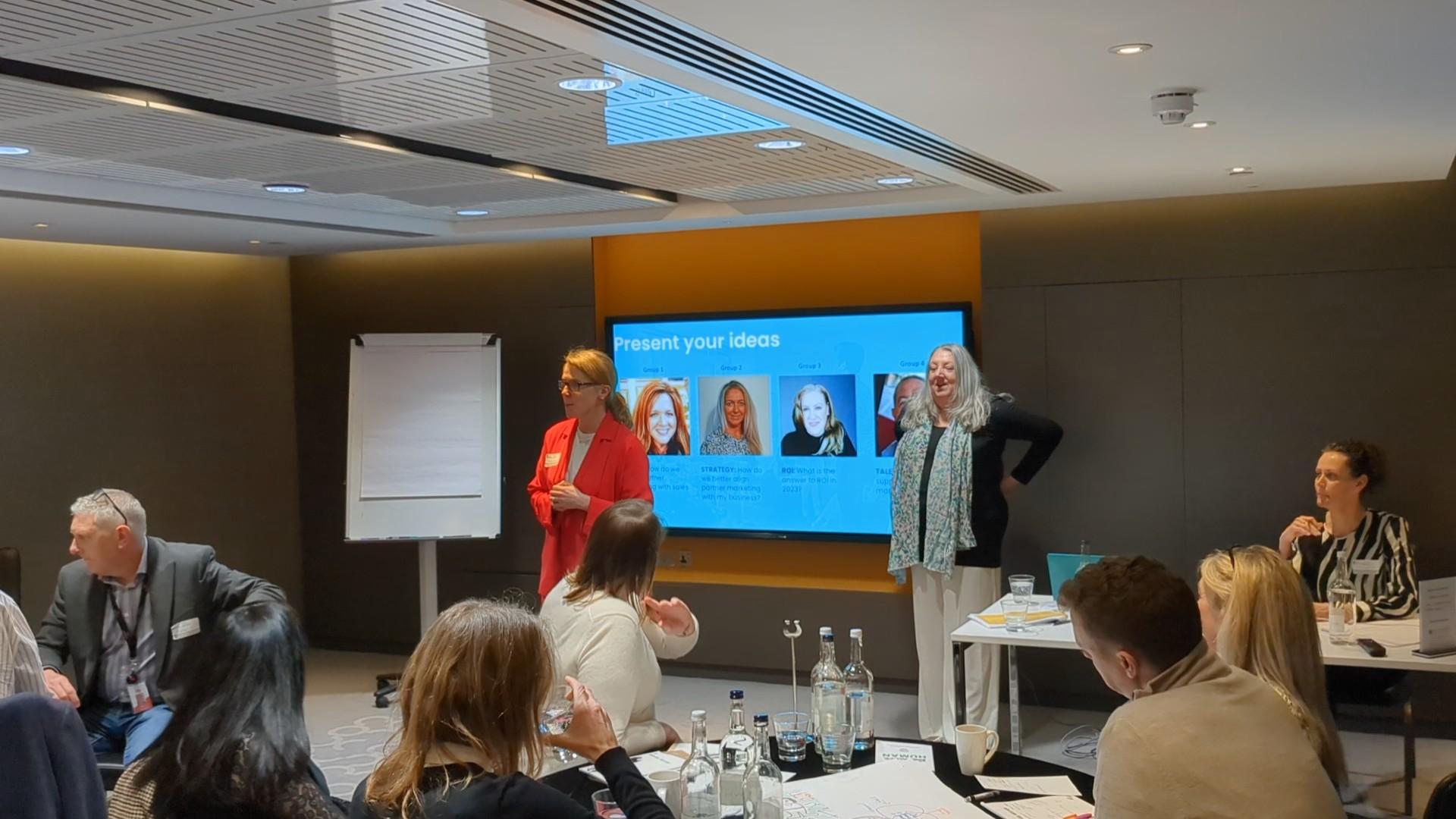Ecosystems and Partner Marketing – ANSWERED.
Big. Bold. Answers. That’s what we were looking for during the latest Coterie Community gathering in London recently.
Attended by about 30 members of the community, the event kicked off with an inspirational talk from author and business entrepreneur Caspar Craven. Having successfully started and sold several businesses, Craven has sailed around the world twice – including once with his family, with three children under 10!

Craven talked about the value of maintaining bold goals and embracing overwhelming challenges, facing conflict and having the dexterity to consider the past, present and future of where you want to go to unlock your potential. All quintessential skills for any partner marketer.
Fully charged, the community broke out into groups and got down to the serious business of the day; answering four key questions (as voted for by the attendees), that could help put partner marketing on the map.
STRATEGY: How do we better align partner marketing with the business?
SALES: How do we align partner marketing with sales better?
ROI: What is the answer to ROI in 2023?
TALENT: How do we support partner marketing talent?
Strategy
QUESTION: Ecosystem marketing has long been the Cinderella of B2B tech marketing (as our research report showed), so how can we encourage more alignment between the business strategy and partner marketing?
Why we need to address this: Without better alignment, ecosystem business growth, scale and efficiencies are prohibited. Resources and energy are spent ineffectively, incentives are blurred and goals are unachievable.
ANSWER: Unsurprisingly, there is no single smoking gun to align strategy with partner marketing. There are however some key elements that the group agreed need to be prioritised. The most important was senior-level buy-in – a channel champion who advocates for partner marketing from the onset of any strategic planning and helps make it relevant for everyone from the sales director to the CTO and CFO and beyond.
A buddy system, whereby executives are paired with partner organisations to immerse themselves in the partner ecosystem is something that’s worked previously for several community members.
Another priority to encourage strategic alignment is the idea of clear, concise company goals and a vision that boasts of partner-centricity. Transparency around rules of engagement, compensation models and shared rewards systems reinforced from the top down will help everyone, regardless of where they reside in the company, pull in the same direction towards a shared goal.
Sales
QUESTION: Sales vs marketing, direct vs indirect – the battle lines are firmly set in many organisations. But, as partner marketers, how can we better align our work with our sales teams’ efforts?
Why do we need to address this? Misalignment between partner marketing and sales has long been a WOMBAT in business (Waste Of Money, Brains And Time). Whether it’s learning to share resources, conflict over who ‘owns’ the lead or what constitutes an SQL or an MQL, lack of homogeneity is hindering growth at best and damaging customer relationships at worst.

ANSWER: We need clarity from the current chaos. There are, this group decided, two ways to achieve this. The first is transparency. Everything from joint goals to sales targets to milestones needs to be shared between sales and partner marketing. With a single strategy, the risk – and the success – are shared. And, when everyone understands what success looks like for their colleagues, an action plan can be developed that ensures both parties are pulling in the same direction.
For example, sharing with the sales team how our budgets, resources and time are split, will aid transparency across teams, and demonstrate how, why and where different activities add value. The 70/20/10 rule could apply; 70% of marketing activity for the year is planned and guided by marketing objectives and KPIs. Following this, 20% is optimised, so can be quickly analysed and measured to find what works best, then amplified to do more of the activities that have performed well, and 10% of budget, time and resource is agile to respond, react or experiment and guided by opportunity. This then allows for bolder thinking.
“70:20:10 is a planning model and philosophy I’ve used successfully for many years.
“It provides confidence business-wide, as we’re planning ahead, but also ensures we have the mindset, resources, budget, headspace and time available to ‘double down’ on elements of the marketing mix that work well and make room for innovation and trialling new things.
“This model/mix can keep a marketing team on track but also motivated to do something different within defined guardrails that allows them to ‘win big and lose small’.”
Michelle Goodall, Chief Marketing Officer at community platform Guild
The second way to better align sales and partner marketing is to build momentum through coalition. By helping sales teams understand why partner marketing matters – improving our value proposition to them – we can start to share a common language that will help us reach bigger common goals.
This could start with something as simple as an appreciation that sales and marketing teams work on different timelines; while sales are interested in quarter by quarter, marketing teams are already working on next year’s campaigns.
ROI
QUESTION: It might be over a century old, but the term ROI is still hard to define and harder still to recognise and measure effectively. So, in 2023 is there a better way?
Why do we need to address this? Often seen as the only measurement of success, ROI is beloved by those who can prove it. But for those of us where it’s not a black and white metric – aka marketing – it’s often the yardstick that we’re simultaneously measured by and beaten with!
ANSWER: The idea of ROI is outdated – that’s the view from the community. Instead, firms should be focused on Value From Investment (VFI). ROI is a misleading, outdated measurement tool that fails to consider the entire lifecycle of the customer, as well as softer elements such as influence and awareness, and only examines specific details within a process, rather than what that process delivers in terms of value for the business.
However, for many, ROI is here to stay and the group discussed ways to make it work. Starting from the outset, all marketing activities such as sponsorships, social media, events, enablement etc need to be measured as much as possible – interactions, downloads, attendance – track everything. This then leads onto pipeline and leads – which is what the sales team are interested in – which then converts into revenue, which is what the board cares about.
To make this effective, the group agreed, takes collaboration and alignment between sales and marketing, which can only happen with shared goals and one strategy that includes partner marketing from the get-go.
This question certainly provided stimulating debate among the community, that’s why we’re planning on covering this in more depth soon.
Talent
QUESTION: There’s been a skills crisis in the tech sector for decades. But when it comes to partner marketers, the complexity of the role and the number of skills required to do a good job feels like it’s growing daily, so how can we better support the new talent?
Why do we need to address this? Coterie research suggests that we’re undergoing skill shortage 2.0 in partner marketing. But without the right people, budgets, innovation and new ideas will wane. How do we encourage tomorrow’s marketers to join our ranks?

ANSWER: Everyone admitted that they ‘fell’ into partner marketing and agreed that no one today talks to their school careers adviser about wanting to get into our sector! One of the reasons is a lack of awareness and understanding about what partner marketing is, what we do and the value it brings. Another is the myriad of skills required and no location or system to learn them all. The group felt this could be addressed with a two-pronged strategy.
The first is to address the skill shortage we have today through on-the-job training. This could be done formally, through mentoring, or by putting internal systems in place for this generation to spend time within each area of the business, from sales, to research to finance, manufacturing and servicing so they have a more rounded, multi-faceted skillset. Underpinning this needs to be an ecosystem value proposition alignment leader – someone who can articulate and evangelise the partner marketing value proposition.
“Accreditation starts with the next-gen of partner market marketers. Today we need to boost alignment with the business so we can demonstrate the value partner marketing delivers, which means in turn more people will want to work in our sector and we’ll have more people from which to recruit.”
Michelle Jones, Channel Business Development Consultant
The second aim should be to develop some formal accreditation that the next generation of partner marketing can achieve that includes all the skills in people, process ad technology a future partner marketer will require.
Conclusion
Like the family dynamics in the TV series Succession, getting answers to some of the pertinent questions facing channel marketers today is complicated.
However, four key themes emerged that impacted all of the answers we discussed;
Education – we need to be better at articulating the ‘why channel marketing is worth it’ value proposition.
Senior buy-in – for an organization to successfully manage a partner ecosystem – including channel marketing – there must be a board-level advocate who understands our value.
Organisational style – Whether your organization is marketing-led or sales-led can have a huge impact on your strategic alignment, goals and attitude of the teams. Clear and defined strategy –
Transparency – we must encourage clear goals, a visible channel-centric strategy and a coalition between teams across the organization, with shared rewards systems in place to encourage teams to be invested in others’ successes.
“The event was so valuable. This is a much-needed brick in the wall of confidence for partner marketers. The engagement and enthusiasm in the room from this fast-growing community show the depth of value and commitment Coterie is creating.”
Marie Thornton, Head of International Marketing, BlueJeans by Verizon




